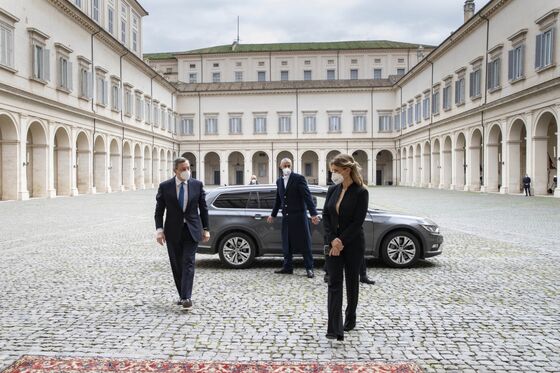They Betrayed Italy’s Last Leader, But Draghi Needs Their Help
(Bloomberg) -- Mario Draghi arrived at the presidential palace alone.
When his car swept into the former summer home of popes in central Rome, the former president of the European Central Bank didn’t even have a secretary. By the time he left his meeting with Italy’s head of state, Sergio Mattarella, 73-year-old Draghi been charged with putting together a government and it was time to start assembling a team.

Draghi will be pursuing talks with party leaders over the next week as he seeks to form a majority that can steer the country out of the coronavius pandemic and relaunch the economy. He’ll also be putting out calls to the trusted associates who will form the inner circle of his administration and help him navigate the often treacherous currents of front-line politics.
But Draghi started off addressing more basic needs -- two senior aides were seconded from the lower house of parliament to help him organize his schedule, according to officials who asked not to be named discussing a confidential issue.
After accepting his mandate, Draghi made a brief speech before heading to his country home two hours north of Rome for the night. He often made such moves while running the ECB, slipping away unnoticed after exhaustive meetings to steal some time alone.
He may well want to gather his thoughts before tackling his next challenge. The Italian economy shrank by 9.2% last year and the International Monetary Fund forecasts growth of just 3% in 2021 with much of the country still under lockdown and more than 90,000 Italians dead from Covid-19.
Government debt is approaching 160% of GDP, way beyond the level which triggered a succession of bailouts for Greece.
Draghi was at the heart of the negotiations that stabilized Greece’s public finances with successive bailouts and kept the country in the euro. If he returns to the European Union leaders’ summit as prime minister later this month, colleagues will think twice before challenging his views on economic and fiscal policy.
But first of all there’s work to do in Rome.
On Thursday morning, Draghi drove himself back into the capital for talks with potential partners in the Queen’s Hall of the lower house. Wearing a protective mask like other visitors, his main aim seemed to be to listen, according to lawmakers involved in the talks who asked not to be identified.
He spoke briefly at the beginning and end of the sessions and his main focus, the lawmakers said, was the urgent need for a successful vaccination campaign and for efficient use of Italy’s 209 billion-euro ($250 billion) share of the EU recovery package.
He has good reasons to be vigilant, as his predecessor at the ECB, Jean-Claude Trichet, might have said.
Twice Betrayed
Italy’s last prime minister, Giuseppe Conte, was twice attacked by allies from inside his coalition, and the second time it proved fatal. The two men who turned on Conte will be crucial to Draghi’s own government.
Former Premier Matteo Renzi triggered Conte’s ouster when he pulled his small Italy Alive party out of the coalition in January.

Renzi and Draghi have known each other for years and were in touch during the machinations that eventually forced Conte to step aside, according to two officials. Renzi had continued talks with his former coalition allies until Feb. 2 and only walked away once he was convinced that Draghi would agree to step in, the officials said.
His group was among the first to confirm its support for Draghi, along with the center-left Democratic Party and Silvio Berlusconi’s Forza Italia.
A Deep Hole
The other key player for Draghi will be Matteo Salvini, leader of the euroskeptic League. Salvini tried and failed to force Conte out in the summer of 2019 and has been leading in the polls even longer, frustrated in his efforts to force the snap election that might have brought him to power.
Salvini’s party has been suggesting that it’s leaning toward supporting Draghi. While the Five Star Movement, born as an anti-establishment, anti-technocrat force, has grudgingly signaled it may follow suit, Draghi needs one of them for a majority.

The reality is that Italy is in a deep, deep hole and the country has no one that can remotely match the former central banker in terms of international credibility. It’s unlikely that Mattarella would have nominated him or that Draghi would have accepted the challenge without a degree of confidence that he’d be able to secure the votes.
Draghi and Salvini will meet in person for the first time on Saturday after speaking by phone earlier and Salvini is already staking a claim to cabinet posts. Supporting Draghi would help Salvini to rebuild his credibility with investors and EU officials ahead of the next election, due by 2023.
As Draghi pursued talks in the lower house Thursday afternoon, Salvini spoke to reporters on a narrow street outside to set out his position. At his side was League lawmaker Giancarlo Giorgetti, the party official closest to Draghi and one who has been lobbying publicly for the ex-central banker to lead the next government.
“We set no conditions, we have no prejudices or vetoes,” Salvini said, before announcing with a theatrical flourish that he was off to buy Giorgetti a coffee at the bar across the road.
Draghi remained inside, sizing up his potential partners and preparing to take charge.
©2021 Bloomberg L.P.